Onion fly: how to deal with an onion pest, how to process it - chemical and folk remedies
It is no exaggeration to say that one of the most common and dangerous pests of onions, which every year torments literally all gardeners, is the onion fly.
Next, you will receive answers to all the basic questions about how to deal with this annoying pest, than how to process onions from an onion fly. And we will start with an analysis of what this insect and its larvae are - the main pests.
Note! Onion flies (or rather their larvae) also damage garlic, shallots, chives, tiered onions and even tulip bulbs.
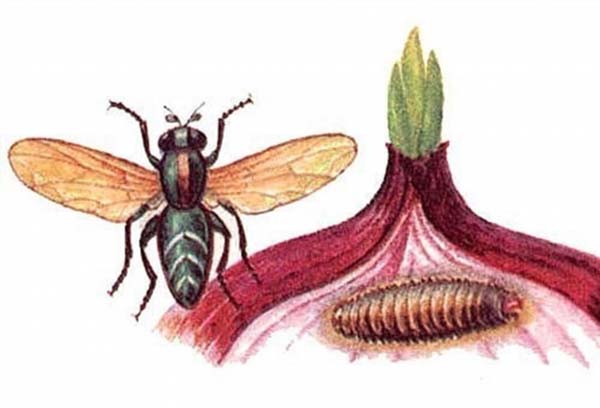
Content
- 1 What does an onion fly look like and what is dangerous
- 2 How to determine that an onion fly has started up on an onion garden: signs of a pest
- 3 Ways to combat onion fly in the garden
- 4 Preventive measures against onion flies: how to protect onions
- 5 How to deal with an onion fly: how to process - the best means
- 6 Folk remedies against onion fly
What does an onion fly look like and what is dangerous
Before you start fighting any garden or garden pest, you need to recognize the enemy by sight. This is necessary in order to notice the insect in time and take action quickly.
So, in its development, the onion fly goes through 4 stages:
- adult insect (imago);
- egg;
- larva;
- chrysalis.
Adult onion fly (imago) - 5-10 mm long, ash-gray color, back with a greenish tint. Outwardly very looks like a common housefly.
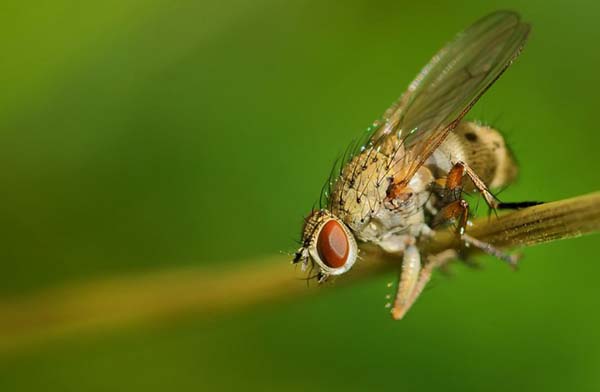
Female flies lay eggs white, elongated and slightly pointed, about 1 mm in size.
Larva - up to 10 mm long, white, cylindrical, without a pronounced head, while the body is slightly narrowed towards the front end.
Pupa (puparium) - about 4-7 mm in size, shiny, oblong-ovoid.
By the way! It is the onion fly larvae that harm the onion, in other words, the fly itself is an indirect pest, the main enemy, its larvae.
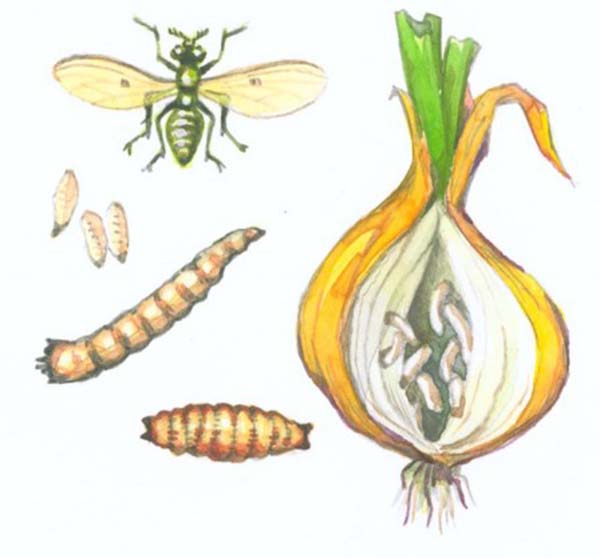
Spring departure onion flies April Maywhen cherry and dandelion blossoms, and maple, lilac, apple, strawberry and elderberry .
By the way! Onion flies fly quite slowly and can be easily caught with your hands.
Females begin to lay eggs literally immediately, placing them directly to seedlings, between leaves or into the soil, near the bulbs. Laying lasts about 12-30 days (sometimes up to 45 days).
After 3-8 days, the hatched larvae immediately penetrate into the bulbs through the base of the leaves in the neck or from the bottom, where, as they live, they eat away (gnaw through) cavities (passages) in them.
Moreover, some larvae are so gluttonous that they can migrate to neighboring bulbs.
At the end of development (after 15-20 days) the larva moves from the bulb into the soil, where at a depth of 3–7 cm forms pupa (puparium)... Then the cycle repeats.
Onion fly larvae damage onions during June and July.
Second generation of onion flies appears at the end of June-beginning of July in the South of Russia, in the Central lane - in July-early Augustthat just coincides with moment ripening onions, therefore, its cleaning should not be postponed in any case.
Interesting! As a result, up to 3 generations of onion flies develop in the southern regions, and 1-2 generations in cooler ones. Pupae (puparia) overwinter in the soil at a depth of 10–20 cm.
Video: onion fly - description and characteristics of the pest (morphology and development)
How to determine that an onion fly has started up on an onion garden: signs of a pest
External signs of onion damage by onion fly larvae are as follows:
- It all starts when the onion stops growing.
- Leaves (from the very tips) turn yellow, acquiring a yellowish-gray tint, wither, and then dry up.
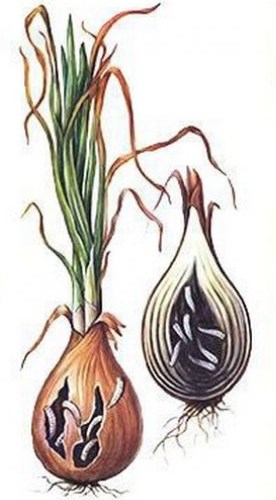
Wherein damaged bulbs become soft and rot and also acquire unpleasant odor.
By the way! At high humidity, decay occurs especially quickly.
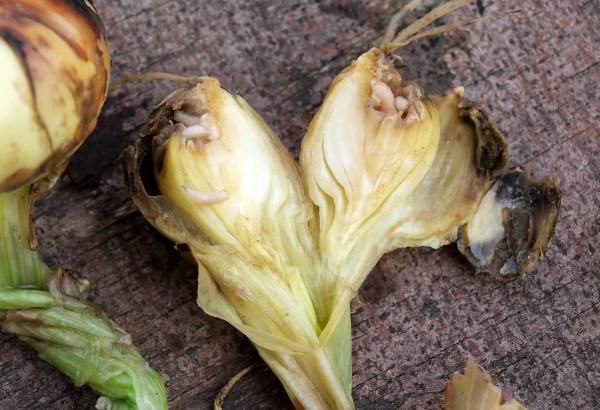
Note! Damage to the bulbs can cause bottom rot (fungal disease)and wet bacterial rot (bacterial disease). The fact is that onion fly larvae can carry pathogens (fungal spores), various bacteria and transmit them to healthy plants.
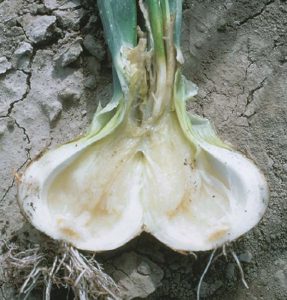
By the way! Onion plants affected neck rot (gray rot of the bulb neck) or stem nematode, especially severely damaged by onion fly larvae.
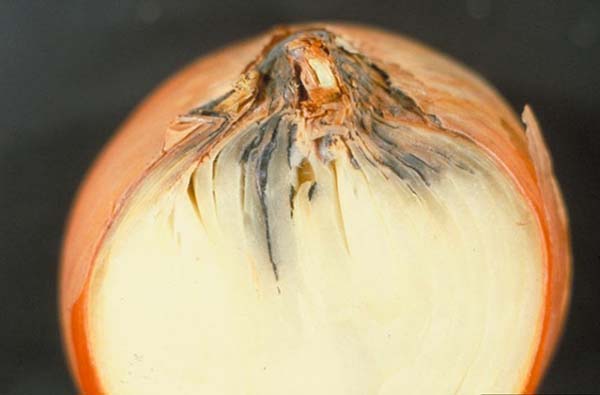
Ways to combat onion fly in the garden
Onion fly control methods can be roughly divided into the following:
- protective or preventive (agrotechnical measures, consisting in proper planting and care), which should help prevent the appearance of onion flies in the garden;
They also include pre-planting of bulbs from an onion fly.
- timely treatment (spraying) onions with chemical insecticides for the direct the destruction of the onion fly.
In addition, there are folk remedies for controlling onion flies, which are more worn deterrent character.
Preventive measures against onion flies: how to protect onions
Agrotechnical measures:
- Destroy or take out all from the site plant residues after harvesting onions.
In no case do not compost the onion foliage, especially if this year there was an infestation of an onion fly.
- Spend deep autumn plowing.
Remember that onion fly pupae hibernate in the soil at a depth of 10-20 cm.
- Plant onions as early as possible in the spring (or do winter sowing).
This will allow you to get away from severe damage by the first generation of the pest and completely get away from the second.
Advice! Alternatively, you can plant onions in the fall before winter.
- Do combined landings: plant onions next to carrots, or even better with calendula or marigolds (namely, alternate them in rows on the same bed or plant around the perimeter). Strong aroma of these odorous plants will interrupt the onion smell and disorient pests.
As planned, carrots will act as an onion fly repeller, and the onion itself will act as a carrot fly.
However! The advice is certainly popular, but it's still more a myth than a really effective remedy.
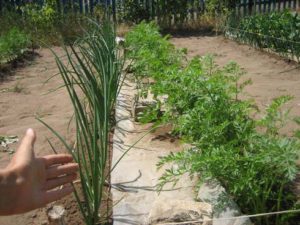
- Observe crop rotation (do not plant in the same place for 2 years in a row) and the rules neighborhood of cultures.
If you grow plants of perennial species and onions nearby, then the pests will simply move from old plants of onion, chives and multi-tiered onions to young shoots.
- Choose the right varieties.
The onion fly does not inhabit spicy varieties with a high content of dry matter (up to 18%) and essential oil (up to 0.05%).
- Weed the beds are very Caution: If you hit a bulb or onion feathers, the smell of a damaged onion will surely attract an onion fly.
How to deal with an onion fly: how to process - the best means
Of course, it is best to approach the fight against onion fly in a comprehensive manner, namely:
- first process the bulbs themselves when planting (more precisely, scatter the granules near the bulbs or over the soil surface),
- and then, if necessary, start spraying with insecticides.
How to process onions from onion flies before planting
For the protective treatment of the bulb, the following insecticidal agents are suitable (the active ingredients, the method of penetration and the chemical class of the drug are given in brackets):
Advice! Granules of all of the following products must be added to the planting hole or scattered over the soil surface when planting the bulbs.
- Zemlin (Diazinon, a systemic insecticide of intestinal action, organophosphorus compounds (FOS) class;
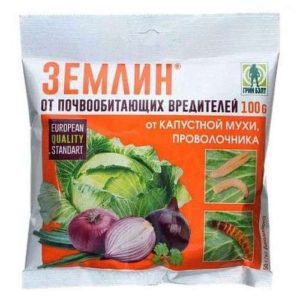
- Pochin (Diazinon, systemic insecticide of intestinal action, class organophosphorus compounds (FOS);
- Terradox (Diazinon, systemic insecticide of intestinal action, class of organophosphorus compounds (FOS);
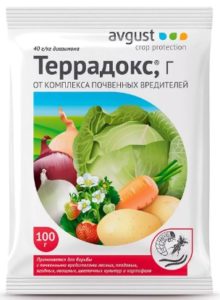
- Flycatcher (Diazinon, systemic insecticide of intestinal action, class of organophosphorus compounds (FOS).
All of the above drugs based on Diazinon are analogs that are sold by different companies.
- Force (Tefluthrin, fumigant - enters the insect's body through the respiratory tract in the form of a gas, a class of pyrethroids);
- Tobacco dust.
Alternatively, you can plant the bulbs by sprinkling them into holes or grooves. tobacco dust, and before spilling them additionally birch tar.
Advice! The site has a separate article about how to soak onions before planting, including for protection against onion flies.
Chemicals for spraying during the growing season
During active summer and egg-laying of the onion fly, it is recommended to use the following insecticidal agents against pests (the active ingredients, the method of penetration and the chemical class of the drug are given in brackets):
- Aktara (Thiamethoxam (Aktara), systemic insecticide of intestinal action, class of neonicotinoids);
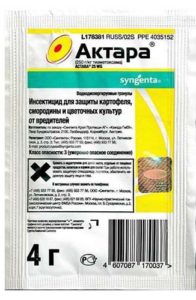
- Corado (Imidacloprid, systemic insecticide of intestinal action, class of neonicotinoids);
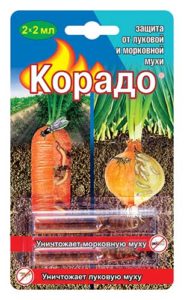
- Vantex (Gamma-cyhalothrin, an enteric-contact insecticide, pyrethroid class);
- Karate Zeon (Lambda Cyhalothrin, insecticide of intestinal action, pyrethroid class);
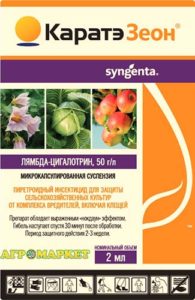
- Alatar (Malathion (Karbofos) and Cypermethrin, an intestinal-contact insecticide, pyrethroid class + organophosphorus compounds (FOS);
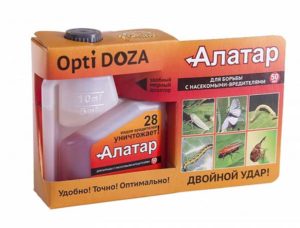
- Sirocco (Dimethoate, a systemic intestinal insecticide, organophosphorus compounds (FOS) class;
- Onion fly (Aversectin, insectoacaricide biological origin intestinal action, avermectin class + biological pesticides).
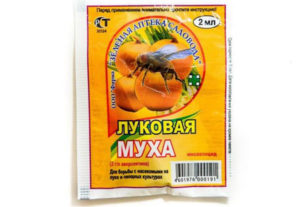
- ExtraFlor (tobacco extract, biological product).
In fact, it is nothing more than tobacco dust, only in a different package.
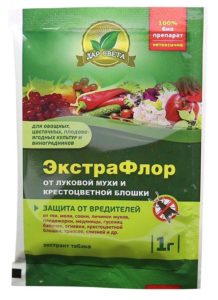
Folk remedies against onion fly
You can also get rid of onion flies in the garden (or rather scare off) with the help of various smelly infusions and strong-smelling compounds, in other words, use folk remedies.
So, you can shed your onion beds following infusions and solutions:
- wormwood;
- coniferous infusion (based on pine twigs;
- tansy;
- mint;
- tomato leaves;
Solutions:
- valerian (recipe: 100 ml of infusion for 10 liters of water);
- ammonia (60 ml of ammonia per 10 liters of water);
- kerosene (50 ml per 10 liters of water);
- table salt (100-200 grams per 10 liters);
The method, of course, is effective, but soil salinization ... is not good. This is very, very bad!
- tobacco dust (200 grams per 10 liters of water).
- turpentine + camphor oil (10%).
Recipe from Procvetok Channel for 10 liters of water (basic):
- turpentine gum (up to 1.5 l - for the most difficult cases for plants with dense leaves, up to 1 l - for difficult cases for more delicate plants (tomato, cucumber), 0.2-0.5 l - for prevention on all plants and in the case of single pests)
- laundry or green soap - up to 50-150 g (depending on the amount of turpentine),
- an aqueous solution of ammonia (25%) - 1-2 tablespoons - to enhance the dissolving effect of turpentine.
Modifications:
- Turpentine can be replaced (up to 50%) with 10% camphor oil.
- You can add 50-100 ml of tincture of mint, eucalyptus, pine extract to the solution.
- You can replace it with decoctions of the same plants - 100-200 g of dry plants are boiled in a liter of water, the decoction is infused and added to the turpentine solution.
- Benzyl benzoate - 20-30 ml per 1 liter of solution.
- It is very good to add nicotinic acid to the solution to restore plants from damage by pests - 1 tablet of 50 mg for each liter of solution (or 3 grams of dry or 12 grams of raw yeast).
Shed or spray the plants with a similar composition in the evening, on well-shed soil.
Expectation period: if without benzyl benzoate, then there is practically none. But first you just need to remove the fruits, then process and wait at least 24 hours. If with benzyl benzoate, it is better to wait 2-3 days. It is clear that vegetables and fruits must be thoroughly washed after any treatments, even if it is just laundry soap or serum.
According to the author, the result of applying this composition of the proposed recipe is almost complete (100%) destruction of the pest.
Or you can still spread out in the aisles of onion plantings rags soaked in valerian.
However, if you have a cat or a cat, then it is better not to do this, because you yourself know what will happen.
Or mulch onion bed pine litter immediately after germination.
And the most effective is considered dusting beds with tobacco dust (as efficiently as possible) or wood ash (less effective), but you can use these two tools at the same time.
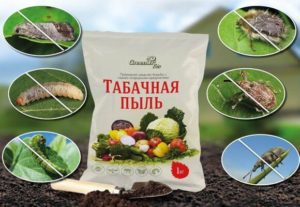
It is worth understanding! Watering and dusting should be repeated after each rain or watering.
Therefore, it is imperative to persist in the fight against onion flour. And for this, it is effective to use various means: for scaring away - using folk methods, for radical destruction - first with protective and preventive measures, and, if necessary, with more modern chemical insecticides.
Video: how to get rid of an onion fly - onion pests

